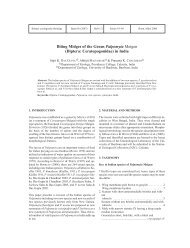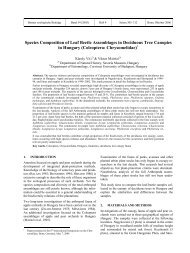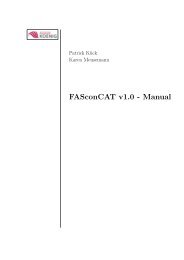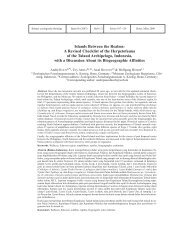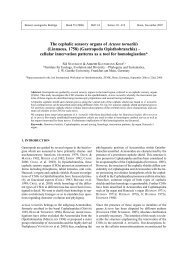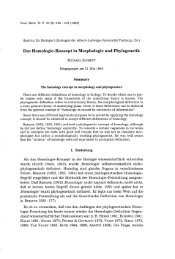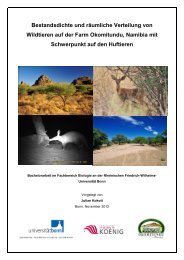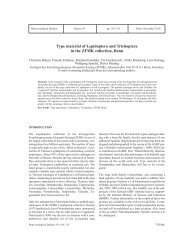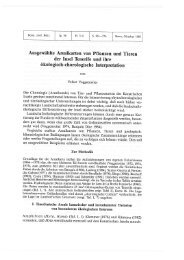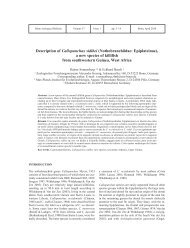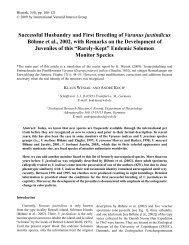Biogeography of the Sacoglossa (Mollusca, Opisthobranchia)*
Biogeography of the Sacoglossa (Mollusca, Opisthobranchia)*
Biogeography of the Sacoglossa (Mollusca, Opisthobranchia)*
You also want an ePaper? Increase the reach of your titles
YUMPU automatically turns print PDFs into web optimized ePapers that Google loves.
266 Ka<strong>the</strong> R. JENSEN: <strong>Biogeography</strong> <strong>of</strong> <strong>Sacoglossa</strong><br />
4. DISCUSSION<br />
<strong>Sacoglossa</strong>ns are small, <strong>of</strong>ten cryptically colored species<br />
and <strong>the</strong>y are <strong>the</strong>refore difficult to collect. This means that<br />
only a few biogeographic provinces have been thoroughly<br />
studied. In recent years international workshops and<br />
biodiversity programs have greatly increased <strong>the</strong> number<br />
<strong>of</strong> sacoglossans known from more remote localities, especially<br />
in tropical waters (JENSEN 1985, 1990, 1993b,<br />
1997b,c, 1999, 2003; JENSEN & WELLS 1990; ICHIKAWA<br />
1993; GOSLINER 1995; SWENNEN 1997, 2001; ORTEA &<br />
TEMPLADO 1988; ORTEA & ESPINOSA 1996, 2000, 2001,<br />
2002; CA B A L L E R et al. 2006; MU N I A N & ORT E A 1997). T h e<br />
present study has reviewed <strong>the</strong> existing information about<br />
sacoglossan distributions and analyzed <strong>the</strong> data for endemicity<br />
and similarity among provinces. Although <strong>the</strong> data<br />
are biased with regards to collecting efforts <strong>of</strong> a few<br />
highly active scientists, several patterns have emerged<br />
from <strong>the</strong>se analyses. The collection bias is most obvious<br />
in <strong>the</strong> areas where few o<strong>the</strong>r observations have been made,<br />
e.g. <strong>the</strong> Brazilian region where basically all collections<br />
have been made by <strong>the</strong> Marcuses. However, <strong>the</strong> species<br />
richness and endemicity does not differ from that <strong>of</strong> o<strong>the</strong>r<br />
tropical regions with no collection bias. The same seems<br />
to be true for <strong>the</strong> Japanese fauna, where Baba has described<br />
most <strong>of</strong> <strong>the</strong> species. The sacoglossan fauna <strong>of</strong> <strong>the</strong><br />
Indian sub-province has been studied by several taxonomists,<br />
but in this case endemicity seems remarkably high.<br />
One reason for this is that descriptions have been published<br />
in local journals and <strong>the</strong>refore overlooked by o<strong>the</strong>r<br />
taxonomists.<br />
Overall <strong>the</strong> distributions <strong>of</strong> sacoglossans correspond to <strong>the</strong><br />
biogeographic regions and provinces identified by<br />
BRIGGS (1995). The exceptions have been pointed out<br />
above. Some <strong>of</strong> <strong>the</strong> provinces identified contain less than<br />
10 species, which means that just one endemic species will<br />
Table 8. Number <strong>of</strong> species and endemicity <strong>of</strong> <strong>the</strong> tropical provinces<br />
and sub-provinces <strong>of</strong> <strong>the</strong> Indo-West Pacific region.<br />
Province/ subprovince # species # endemics (%)<br />
Western Indian Ocean 27 5 (19)<br />
Red Sea 10 2 (20)<br />
India s.l. 20 10 (50)<br />
Indo-Malayan 48 9 (19)<br />
Central Pacific 51 4 (8)<br />
Ryukyu 33 10 (30)<br />
Hawaii 25 6 (24)<br />
S Pacific 33 6 (18)<br />
Nor<strong>the</strong>ast Australia 28 2 (7)<br />
+ Great Barrier Reef<br />
North and Northwestern 23 4 (17)<br />
Australia<br />
yield more than 10% endemicity. Obviously this cannot<br />
be used to make conclusions about <strong>the</strong>ir distinctiveness.<br />
The records listed in existing literature do not usually have<br />
longitude and latitude, and many locality names are ambiguous<br />
or oblivious. Consequently it has not been possible<br />
to construct a “degree-by-degree” plot <strong>of</strong> species distributions<br />
for analysis. Never<strong>the</strong>less, <strong>the</strong> latitudinal decrease<br />
in species diversity from warm to cold temperate<br />
provinces is spectacular. <strong>Sacoglossa</strong>ns are dietary specialists<br />
and <strong>the</strong> majority <strong>of</strong> species feed on siphonaceous green<br />
algae, which are much more abundant and diverse in tropical<br />
and warm temperate waters. The cold temperate<br />
sacoglossan faunas <strong>of</strong> <strong>the</strong> North Atlantic as well as <strong>the</strong><br />
Nor<strong>the</strong>ast Pacific Ocean are mostly eury<strong>the</strong>rmic species<br />
with wide latitudinal distributions, extending well into<br />
neighboring warm water regions; indices <strong>of</strong> inclusion are<br />
over 60% (Tables 3b, 4b). This is also seen in Japan (Ta b l e<br />
5b) and sou<strong>the</strong>rn Africa between <strong>the</strong> tropical western Indian<br />
Ocean and <strong>the</strong> warm temperate southwestern Africa<br />
(Table 7b), but not nearly as pronounced in Australia<br />
(Table 6b). This apparently supports Rapoport’s rule that<br />
species ranges in high latitudes are larger than in low latitudes.<br />
However, <strong>the</strong>re are great differences between <strong>the</strong><br />
provinces. The Nor<strong>the</strong>ast Pacific coldwater fauna is 43%<br />
<strong>of</strong> <strong>the</strong> tropical fauna, <strong>the</strong> Nor<strong>the</strong>ast Atlantic boreal fauna<br />
is 21% <strong>of</strong> <strong>the</strong> combined Lusitanian and Mediterranean fauna,<br />
and <strong>the</strong> Northwest Atlantic boreal fauna is only 12%<br />
<strong>of</strong> <strong>the</strong> Caribbean fauna.<br />
The number <strong>of</strong> amphi-Atlantic species is relatively high,<br />
especially for <strong>the</strong> warm-water/tropical faunas (ORTEA et<br />
al. 1997; present study); 16 species (about 30%) occur in<br />
<strong>the</strong> Caribbean and <strong>the</strong> Lusitanian and/or Mediterranean<br />
provinces. However, amphi-Atlantic distributions for most<br />
<strong>of</strong> <strong>the</strong>se species have only been recognized in recent years<br />
(TEMPLADO et al. 1990; ORTEA et al. 1988, 1998), and it<br />
cannot be excluded that human introductions are involved.<br />
Contrary to this, only one cold-temperate species, Her -<br />
maea vancouverensis, has an amphi-Pacific distribution.<br />
Alderia modesta has a circum-boreal/arctic distribution.<br />
Elysiella pusilla has recently been recorded from <strong>the</strong> Mexican-Panamanian<br />
province (BE H R E N S & HE R M O S I L L O<br />
2005). However, it cannot be excluded that this is a human<br />
introduction. The same is true for E rc o l a n i a<br />
boodleae, a Japanese species, which has been recorded<br />
from California (BEHRENS 1991); this may also be a<br />
misidentification (TROWBRIDGE 2002). The so-called circum-tropical<br />
species, Elysia ornata a n d E rc o l a n i a<br />
coerulea, are conspicuously absent from tropical eastern<br />
Pacific; <strong>the</strong>y extend from <strong>the</strong> Caribbean to <strong>the</strong> South<br />
and/or Central Pacific islands. Lobiger souverbii, which<br />
has been synonymized with several Indo-West Pacific<br />
species (KAY 1964; BA B A 1974; GO S L I N E R 1987a; GO S L I N-<br />
E R et al. 1996), and which occurs in <strong>the</strong> Caribbean as well




